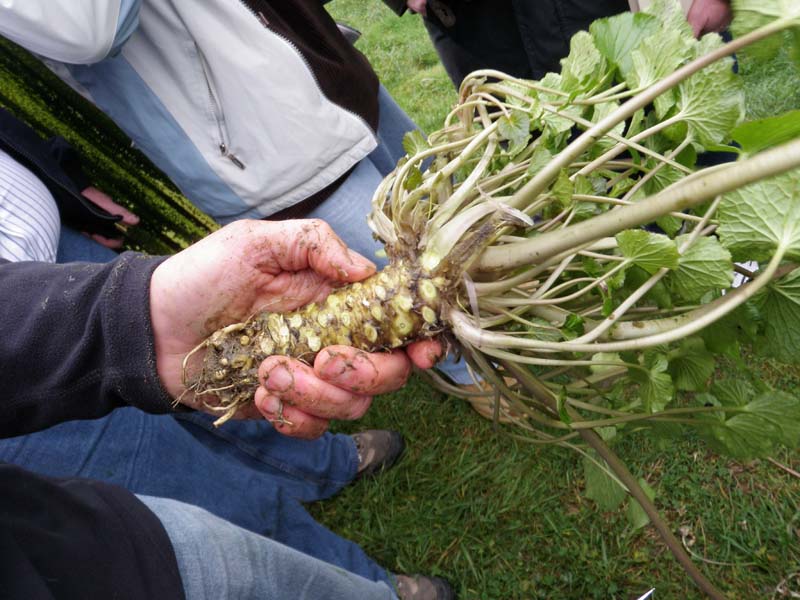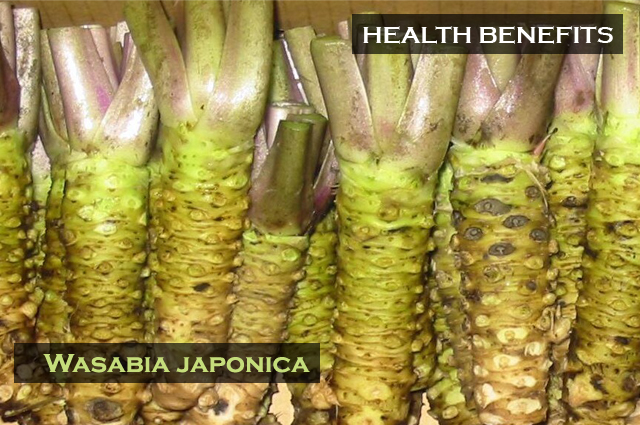Eat more Wasabi
Six Reasons Why You Should Eat More Wasabi
Whether you've been out for sushi or browsing the international aisles at your grocery store, you might have noticed a green paste or powder called wasabi.
Wasabia is a spicy green Japanese condiment that was originally made from the herb Wasabia japonica. Wasabia japonica rhizome is a rich source of unique long-chain methyl isothiocyanates that have been shown to help maintain healthy liver enzymes and DNA, as well as support a healthy anti inflammatory process.
Why else should you be eating more wasabi?
Listen in as the Wasabi Maestro (Michel Van Mellaerts) shares the powerful benefits of wasabi and why you should be eating more of this food.
In the following article I shall call the authentic plant product Wasabia, and the fake product wasabi.

Let's talk about why we all should be eating more Wasabia. You know, that green paste you get with sushi. Although that paste you get with sushi in restaurants and sushi bars is probably not Actual Wasabia and I will get into that in a moment. That small amount of green paste that clears your sinuses, gives you that real kick and wake up call, your eyes water and then it's gone and you just feel awesome. I love it. We should be eating more Wasabia. Let me just tell you about Wasabia. Let's discuss the Wasabia japonica story because that's the plant name. Wasabia japonica has been grown and eaten in Japan for centuries. It is believed that the daily consumption of this plant Wasabia japonica improves the health and fights off a large number of illnesses.
This has now been borne out in a large and increasing number of scientific studies on the actions of these naturally occurring compounds in Wasabia. For centuries, there have been a lot of traditional uses of Wasabia, a lot of anecdotal evidence, historical evidence, even folklore, surrounding Wasabia and its medicinal properties.
More and more scientists are starting to back up what traditional users of Wasabia have always known: it's good for you.
More and more people are seeing Wasabia as a functional food for human health--consuming it on a daily basis. Let me just tell you the problem, though. At least in the United States, when you think you are eating the wasabi plant, we are probably not. Wasabia is hard to grow and cultivate mainly because it has to be done at higher elevations.
Of course, in higher elevations the temperature can change so much and if it gets too warm the wasabi plant doesn't do too well and if it gets too cold it doesn't do well. So, there's this right elevation, this perfect elevation, where it's not too cold and not too warm in the mountains of Japan. Yet people don't want to go up there and cultivate the plant anymore. Then you add to the fact that there's so much pollution in Japan and the bottom line is the actual plant Wasabia japonica is not really grown that much anymore because it's just too hard and no one wants to do it.
Here's what the Japanese did, knowing that there was going to be a massive demand in Western countries for the unique flavour of Wasabi.
The Japanese have a great business eye for this kind of thing. In order to make up for the reduction in Actual Wasabia, the Japanese food industry provided a solution. They took powder or paste that contains European horseradish mixed with mustard seed and FDA approved coloring. So, that green stuff that you thought was wasabi that you are getting with your Westernised sushi is horseradish with food coloring in it and maybe a little mustard seed. And it's really not providing that much benefit.
Horseradish does have some benefits but not to the level of Wasabia. So, when you think you are eating wasabi in all countries in the world, you probably aren't. You can get it but you have to ask for it. It's going to cost a little bit more but it's worth it. When you look at the Wasabia plant, the most important part of it is the swollen stem (rhizome). There's a specific type of compound in the rhizome called an isothiocyanate. That's the key compound that we want from the Wasabia.
I did some research after learning about Wasabia and learning about how hard it is to grow the plant and cultivate it and then learning about how the Japanese have a kind of work-around with horseradish, I decided I'm going to do some straight forward, good, old-fashioned research on PubMed to find out what the true benefits of Wasabia that contain these unique isothiocyanate [Iso-thio-cy-an-ates] compounds are.

Here's what I found.
Number one
Actual Wasabia with isothiocyanates inhibits the development of lung tumors, at least in mice. There are a lot of cancer researchers who are now are pushing the NIH to do some human clinical trials with Wasabia standardized to a fixed level of isothiocyanate.
This was published in Cancer Letters 2000. There hasn't been much follow up with this, I don't think. If you go to clinicaltrials.gov, you can search "wasabi" and/or "isothiocyanate" and "lung cancer" and see what kind of trials are out there. I don't think there are too many. The use of Wasabia to cure Lung Cancer has been shown to work, at least in mouse models.
The latest studies (2019) are showing that the active ingredients in Wasabia japonica kill nearly all types of Cancer cells. I shall be addressing these cancers in future articles.
Number two
Actual Wasabia has potent antibacterial activity. Now, this has been known for a long time and this has probably been one of the big reasons that traditional cultures have used actual Wasabia in wounds and when people are sick with cold, flu, whatever.
Historically speaking, they made the claims it works wonders but now there is some research evidence that it truly does have at least antibacterial activity and is also anti-viral. The International Journal of Food and Medicine, 2004 did a really good study on this. The Biological Sciences and Biotechnology Biochemistry journal, published in 1998 some research looking at the antibacterial activity and it does seem to have some.
Some hospitals are now using Wasabia based cleaning products to overcome Golden Staph infections are appear to be endemic in most hospitals.
Number three
Actual Wasabia suppresses glandular stomach cancer.
This is a good one. We don't have a lot of good treatments for stomach cancer. This study was published in Nutrition and Cancer, 1991.
Looking at actual Wasabia with isothiocyanates and the effect on cancer was positive and the results published in a peer review journal a long time ago. Again, go to clinicaltrials.gov and there's not a lot of follow up with these things and that's a shame.
Number four
Wasabia has some antiplatelet properties so it can help work in kind of the same way aspirin does. A study has shown that Wasabia works almost immediately compared to the 10 minutes that aspirin normally takes to reduce pain.

In a post-stroke type situation or maybe even used in combination with other anti-platelets with people with A-fib to prevent blood clot formations Wasabia would be useful. This was shown to be true in a study that was published in the Biofactors journal in 2000.
There's a number of traditional benefits of Wasabia, a lot of historical, anecdotal claims about Wasabia and those claims are now being backed up with solid, peer reviewed publications, sometimes in animals, sometimes in a petri dish, sometimes in humans.
Number five
Wasabia increases the abundance of protective detox enzymes. Those are your liver enzymes. Detox is a big issue.
We know that we have a built in, really awesome detox system called the liver. But the liver is being overwhelmed in today's environment, so it needs help. Wasabia can be that help.
The Journal of Biology and Chemistry, in 2002 showed that Wasabia can enhance the activity of phase I and phase II detoxification paths in the liver. Other things that can do that are milk thistle, melon extracts, B Vitamins and now you can add Wasabia to that list.
Number six
Wasabia has a protective effect against colon cancer risk.
This study was published in Nutrition and Cancer in 2004. Just a lot of really good benefits of Wasabia but you have to make sure you're using Actual Wasabia japonica if you are going to eat and consume it.
The latest studies show that Wasabia japonica is actually capable of killing almost every type of cancer.
If you are going to buy a product make sure it is only Actual Wasabia and not the generally available horseradish blend.
Here are some products that do contain 100% Pure Wasabia japonica rhizome with no additives of any type. These products contain a very high level of the active ingredients that studies have shown kill cancers and maintain a healthy body.
100% Pure Wasabia japonica products that have the health benefits mentioned above can be found at https://organicremedies.com/products

